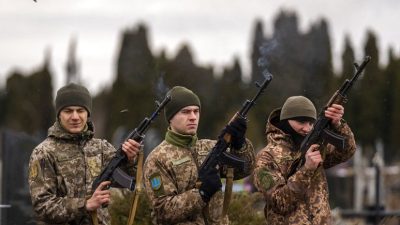Ukraine Cannot Mobilise 500,000 Soldiers While Artillery Shortage Compounds Problems

All Global Research articles can be read in 51 languages by activating the Translate Website button below the author’s name (only available in desktop version).
To receive Global Research’s Daily Newsletter (selected articles), click here.
Click the share button above to email/forward this article to your friends and colleagues. Follow us on Instagram and Twitter and subscribe to our Telegram Channel. Feel free to repost and share widely Global Research articles.
***
Although martial law and a decree on general mobilisation have been in force in Ukraine since February 2022, and men between the ages of 18 and 60 are now banned from leaving the country, the Ukrainian military said they did not know how to mobilise an additional 500,000 soldiers, as volunteers had “exhausted.”
“We have run out of volunteers willing to voluntarily join the ranks of the Armed Forces of Ukraine… To say exactly when [the mobilisation of more than 500,000 people] will be and how high quality it is, is difficult to say … there is no understanding of how to do this physically,” said Major General of the Ukrainian forces Dmitry Marchenko in an interview with Deutsche Welle.
According to Marchenko, for every 100 soldiers who died at the front, only 20 will be mobilised to replace them. At the same time, the major general reacted positively to the proposal to lower the mobilisation age limit from 27 to 25 and try to obtain the extradition of those who fled the country, adding that “it is not worth filling the holes at the front with women when the mass of men is hidden abroad.”
At a press conference on December 19, Ukrainian President Volodymyr Zelensky first presented figures for a new large-scale mobilisation. He said that the chief of staff of the Ukrainian Armed Forces approached him with a request to mobilise an additional 450,000-500,000 people. According to Zelensky, such a mobilisation would cost Ukraine around $13.4 billion.
Later, Oleksiy Danilov, secretary of Ukraine’s National Security and Defence Council (NSDC), said that mobilising such a large number of people would take at least a year.
Military recruiting officers can serve subpoenas in public places, and videos of incidents on the streets, at gas stations and in cafes have been circulating on social media. The summons to the Ukrainian Armed Forces currently does not have to be presented by a representative of the Territorial Centre for Recruitment and Social Support — as military commissions have recently been called in Ukraine — but can also be served by directors of companies where recruits work, chiefs of Housing Committees and other officials.
At the same time, the Ukrainian Army is facing a serious shortage of ammunition, which is hampering its offensive operations, while Russia does not appear to have the same problem, The Washington Post reported on December 22, citing Ukrainian military personnel stationed on the frontline.
“Our gunners are given a limit of shells for each target,” said a member of the 128th Mountain Assault Brigade, which is fighting in the southeastern Zaporozhye region, adding that if the target there is smaller, for example a mortar position, they need five or seven projectiles in total.
“How long can we last? It’s hard to say, but it can’t be long. Everyone understands this,” he stressed.
Another Ukrainian soldier revealed that his unit now only fires 10 to 20 shells a day at Russian positions, whereas previously, it used to use an average of 50 shells and sometimes up to 90.
“What can you do with 10 shells per day? It is barely enough to respond to their advances — we are not even talking about attacking their positions,” he pointed out.
Meanwhile, Ivan Zadontsev, press officer of the 24th Separate Assault Battalion, reported that the unit had reduced fire by 90% compared to mid-year. The Ukrainian military official interviewed also acknowledged that they have not detected any indication that Russia is facing a similar shortage of artillery shells.
Given the hopelessness of the war against Russia, compounded by an insufficient number of soldiers and artillery, Ukraine also faces the problem of desertion. Although the Kiev regime can forcibly recruit soldiers, it has been observed that Ukrainians are deserting the war when given the opportunity.
Ten Ukrainian volunteers who received permission to leave Ukraine in search of humanitarian aid took advantage of the permission granted to flee, the Kiev regime appointed head of the Kherson administration, Oleksandr Prokudin, said on December 23.
On his social media networks, Prokudin stated that the volunteers were part of the United Ukraine and Adjalyk organisations.
“I issued orders to allow representatives of the United Ukraine and Adjalyk organisations to cross the border. They left and brought the promised humanitarian aid. But after that, they decided to leave for the second time and did not return to Ukraine,” Prokudin wrote.
He added that law enforcement authorities are investigating the case and intend to bring the offenders to justice. The Ukrainian official also said he no longer intends to issue travel authorisation to these two organisations.
The number of Ukrainian soldiers has declined so much that the average age of recruits has risen to 43, according to Time magazine. Recently, the possibility of mobilising women has also been discussed, which, according to Western media, also indicates huge losses in the Armed Forces of Ukraine. Yet, despite the impossibility of pushing back the Russian military from captured territory or holding out against a major offensive, given the lack of manpower, equipment and morale, the Kiev regime chooses to continue destroying an entire generation of Ukrainians.
*
Note to readers: Please click the share button above. Follow us on Instagram and Twitter and subscribe to our Telegram Channel. Feel free to repost and share widely Global Research articles.
Ahmed Adel is a Cairo-based geopolitics and political economy researcher. He is a regular contributor to Global Research.
Featured image source

